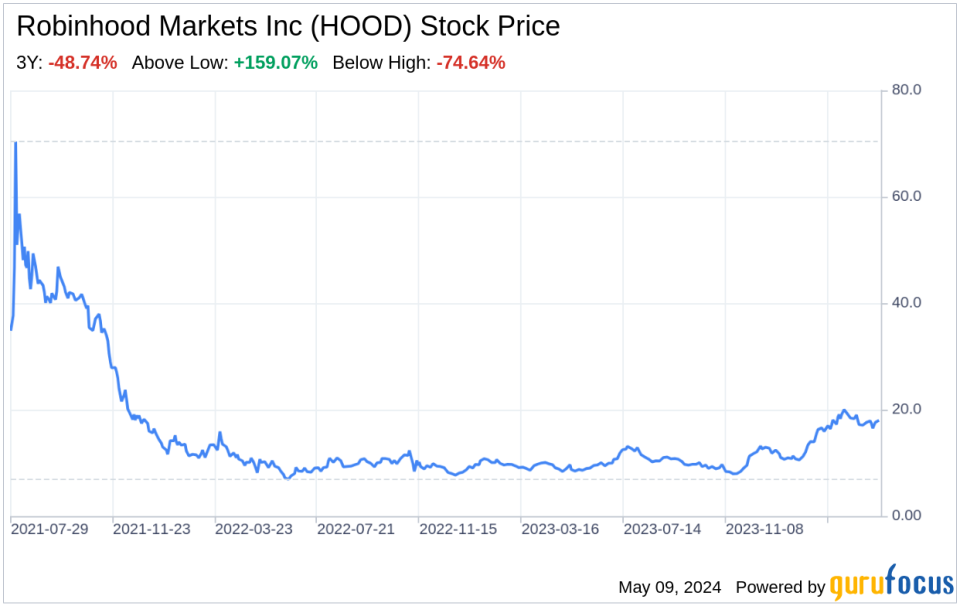Decoding Robinhood Markets Inc (HOOD): A Strategic SWOT Insight
Robinhood Markets Inc (NASDAQ:HOOD) showcases a robust financial turnaround with a net income of $157 million in Q1 2024, a significant leap from a net loss of $511 million in Q1 2023.
Transaction-based revenues surged to $329 million, underpinning the company's growth trajectory and market adaptability.
Despite market volatility, Robinhood's strategic initiatives and technology investments position it well for capturing emerging opportunities in the financial sector.
Regulatory challenges and competitive pressures remain pivotal factors in shaping Robinhood's operational landscape and future growth prospects.
On May 8, 2024, Robinhood Markets Inc (NASDAQ:HOOD) filed its 10-Q report, revealing a transformative financial landscape compared to the previous year. The company, known for its innovative, app-based financial services platform, reported a striking shift from a net loss of $511 million in Q1 2023 to a net income of $157 million in Q1 2024. This remarkable financial rebound is primarily driven by a substantial increase in transaction-based revenues, which soared from $207 million to $329 million. Robinhood's strategic focus on expanding its product offerings, including cryptocurrency trading and fractional shares, has evidently paid off, positioning the company as a formidable player in the modern financial services arena. However, the company's operating cash flow took a downturn, with a net cash used in operating activities of $(623) million, indicating areas that require strategic financial management. This SWOT analysis delves into the strengths, weaknesses, opportunities, and threats as disclosed in the recent SEC filing, providing investors with a comprehensive perspective on Robinhood Markets Inc (NASDAQ:HOOD).

Strengths
Financial Resurgence: Robinhood's financial performance in Q1 2024 underscores a significant strength, with a net income of $157 million, a stark contrast to the net loss of $511 million in the same period last year. This turnaround can be attributed to the company's ability to increase transaction-based revenues by 59%, from $207 million to $329 million, reflecting the effectiveness of its business model and the growing adoption of its platform by users seeking commission-free trading and innovative financial products.
Technological Innovation: Robinhood's proprietary technology and vertically integrated platform have been pivotal in introducing new services such as cryptocurrency trading and fractional shares. The company's commitment to technological advancement is evident in its reduced technology and development expenses, which decreased from $199 million to $196 million, showcasing efficient resource allocation and a focus on sustainable growth through innovation.
Weaknesses
Operational Cash Flow Concerns: Despite the impressive net income, Robinhood's operational cash flow presents a weakness, with a net cash used in operating activities of $(623) million. This figure indicates a significant cash outflow, which could be a concern for the company's liquidity and its ability to sustain operations without external financing. The company will need to address this cash flow challenge to ensure long-term financial stability and investor confidence.
Dependence on Transaction-Based Revenues: Robinhood's reliance on transaction-based revenues, which constitute a significant portion of its total net revenues, is a potential weakness. This dependence exposes the company to market volatility and regulatory changes that could impact trading volumes and, consequently, its revenue streams. Diversifying its revenue sources could mitigate this risk and contribute to a more resilient business model.
Opportunities
Market Expansion: Robinhood has the opportunity to capitalize on its strong brand and customer base by expanding into new markets and introducing additional financial products. The increase in net interest revenues from $208 million to $254 million suggests a growing interest in the company's offerings, which could be leveraged to explore untapped market segments and drive future growth.
Regulatory Landscape: The evolving regulatory environment presents opportunities for Robinhood to differentiate itself by proactively addressing regulatory requirements and setting industry standards. By leading in compliance and consumer protection, Robinhood can enhance its reputation and attract customers who value transparency and security in their financial transactions.
Threats
Competitive Pressures: The financial services industry is highly competitive, with incumbents and new entrants continuously innovating to capture market share. Robinhood faces the threat of competitors replicating its commission-free model and offering similar or superior products, which could erode its competitive advantage and impact its market position.
Regulatory Risks: Robinhood's business model, particularly its reliance on payment for order flow (PFOF), is subject to regulatory scrutiny. Changes in regulations or a ban on PFOF could significantly disrupt the company's revenue model and necessitate a strategic pivot, posing a substantial threat to its financial health and operational strategy.
In conclusion, Robinhood Markets Inc (NASDAQ:HOOD) has demonstrated a strong financial recovery, leveraging its technological prowess and innovative product offerings to achieve significant growth in transaction-based revenues. However, the company must address its operational cash flow concerns and dependence on transaction-based revenues to fortify its financial foundation. Opportunities for market expansion and navigating the regulatory landscape with foresight can propel Robinhood to new heights, while competitive pressures and regulatory risks require vigilant management. Overall, Robinhood's strategic initiatives and market positioning suggest a promising trajectory, albeit with challenges that necessitate careful strategic planning and execution.
This article, generated by GuruFocus, is designed to provide general insights and is not tailored financial advice. Our commentary is rooted in historical data and analyst projections, utilizing an impartial methodology, and is not intended to serve as specific investment guidance. It does not formulate a recommendation to purchase or divest any stock and does not consider individual investment objectives or financial circumstances. Our objective is to deliver long-term, fundamental data-driven analysis. Be aware that our analysis might not incorporate the most recent, price-sensitive company announcements or qualitative information. GuruFocus holds no position in the stocks mentioned herein.
This article first appeared on GuruFocus.

 Yahoo Finance
Yahoo Finance 